The Fariña Files | home
Vanguard collectors' guide | Vanguard Labels | Title 67 | Vanguard Singles, 1960-1970 | Vanguard - selected discographies | Vanguard - 1960-1970 | Dick & Mimi's LPs - a guide | Dick & Mimi's LPs: Singer/Songwriter | Dick & Mimi's LPs : Reflections In a Crystal Wind | SF Chronicle obit, from AVRS-21354 | Reflections photo session | Dick & Mimi's LPs - Memories | Dick & Mimi's LPs- The Best of... | Farina : Covers & Oddities | Elektra - selected discography | Selected contemporary discography
Vanguard collectors' guide
+ Singles
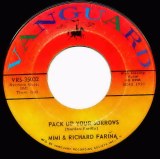 |
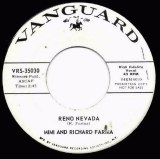 |
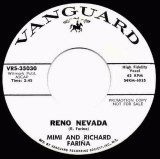 |
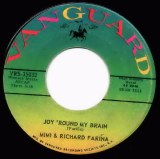 |
Though the '60s were alleged to be a prime time for the folk revival, not much money was actually made by The Folk : it was far more liklely to be made by carefully groomed and calculatedly upbeat mercilessly professional single acts or groups of ex-college frat boys signed to major labels than eastern college drop-outs with politics and Leadbelly on their minds, signed to get-poor-quick labels like Folkways or Prestige or Vanguard.
Folk music was more of a spice and influence than a presence on the top 40 for most of the revival. Following a spate of history songs sung by country artists ("folk" was very widely defined until the mid-sixties) in the late 50s, like "Sink the Bismarck" by Johnny Horton, and Stonewall Jackson's "Waterloo", the first recognizable folk act to get hit singles were the Kingston Trio (signed to Capitol), who had ten top 40 singles between "Tom Dooley" in the fall of 1958 and "Reverend Mister Black" in the spring of '63. The Highwaymen probably sent more than their share of trees and petroleum to a fiery end with "Michael, row the boat ashore" (United Artists), and Lonnie Donnegan brought British skiffle late into the mix with "Does your chewing gum lose its flavor..." (Dot) in September, 1961, with the Highwaymen returning with "Cottonfields" in February, '62. Uniquely unreformed beatniks, Peter, Paul & Mary (Warner Bros.) had twelve top 40s between June, '62 ( "Lemon Tree") and November, '69 ("Leavin' on a jet plane"). The New Christy Minstrels (Columbia), a way-too-large and seriously peppy assembly of tambourine-whackers and toothy grins had three top 40 hits in 1963-64, including "Green, green " in July of '63. "Don't let the rain come down" was a number 10 for the Serendipity Singers (Phillips) in May of 1964, and Gale Garnett had a hit with the self-penned "We'll sing in the sunshine" for RCA in September of '64. Though most would have been more at home in the local dinner theatre than the local folkie dungeon, the commercial folk groups at least let people know there was more (and usually better) music if you wanted to look.
It should be noted that in July of 1964, the Animals, a white blues band from Manchester riding the British Invasion as it swept from England's imaginary delta, released their first US single - a four-and-a-half minute version of the traditional "House of the Rising Sun", giving more than one urban neo-traditionalist a glimpse at the wave to come within the next year. Peter, Paul & Mary stayed true to their political roots, their vision of a borderless music and integrity ("Uh, we want this next song ['I dig rock and roll music'] to be our next single. Our manager says Over His Dead Body...", they announced at one concert), recording and releasing a single by the then-unknown songwriter, Bob Dylan ; "Blowin' in the wind" would hit number one in July of 1963. This single would light a slow fuse that would burn until it hit the mother load during the summer of 1965, when "Tambourine man" by the Byrds would clear the way for folk's mutation into an electric era, followed quickly by Dylan himself with "Like a rolling stone".
Singles quickly became a major, radio-friendly medium for folksingers. As long as they had drums behind them.
|
|
Vanguard was never a hit-making machine, and their vision of commerical success was based on album sales, not singles, and considering their niche in popular music, this is sensible business. As a result, not many singles were ever issued by Vanguard.
Their numbering theoretically would have started with VRS-35001 in 1959 or so, reaching 35017 by early January, 1961 when the Rooftop Singers had the label's first and probably last #1 hit, with "Walk Right In" (Joan Baez gave them their second brush with the top five in 1971 with her lyrically-challenged version of the Band's "Night they drove old Dixie down", which went to #3). The label went into a tizzy, and besotted with success, went whole hog on the group's next two releases printing four-color picture sleeves for each, an extravagance they would not rush into again for four years, and then only for Joan Baez (VRS-35031, "There but for fortune"). By the end of the '60s, they'd gotten all the way up to 35091 (Buffy Sainte-Marie's "Better to find out for yourself", from her 1969 Illuminations album).
So they didn't release anywhere close to one hundred singles during what would be the commerical hayday of folk music, and thus their moment in the sun. But then, from a strictly business standpoint, it makes sense because there wasn't much of a market for folk singles - most people interested in folk music weren't two-and-a-half-minute-danceable-single types.
Vanguard seems to have gotten their singles out to record stations, as it is far more common to find a white promotional label than their stock label for a great many of their singles. I'm sure at least a handful of their singles sold in relatively good numbers, but hits were alien territory for them, and so huge pressings for any of their singles were not likely.
|
1st Single Label
|
1959-1962
|
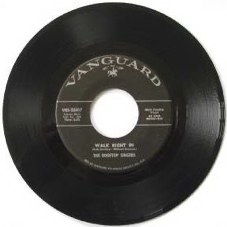 |
VRS-35017 - Rooftop Singers - Walk right in/ Cool water (released late '62, #2 on the hit parade, Feb. '63)
Their labels were very distinctive. First was a black label which lasted from 1959 until late 1962, and included the first singles by Joan Baez, most of the Weavers' singles and here and there an Odetta release.
|
Their promotional labels were the standard white, with the layout the same as a stock issue but minus color. All bore the traditional skull-and-crossbones warning, "Demonstration copy - Not For Sale"
|
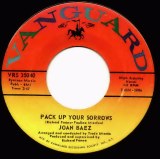 |
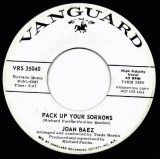 |
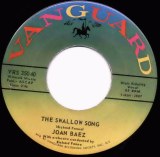 |
VRS-35040 - Baez, Joan : Pack Up Your Sorrows/The Swallow Song (released June '66)- the first label noted is the A side, using the yellow-to-red design; the middle is a white label promotional copy of the same single's A side ; third is the B side, with the yellow-to-blue design. Vanguard didn't seem to favor one color scheme over the other when it came to denoting the A side or the B side.
|
Here we have the sand in the sun tan lotion:
|
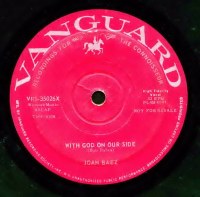 |
VRS-35026X - Baez, Joan. With God on our side (live) / Railroad Bill (live) / Rambler Gambler (live) (jukebox promo - released June, 1964).
This is a Vanguard jukebox promo single released in June, 1964.
It uses the same design and color scheme as the LP of the same period.
It's marked "Not For Resale" on the right center, just below the note that this is 33 rpm, rather than the normal 45 rpm. It has a small spindle hole rather than the normal gaping one. It is, however, a single. The catalog number adds an "X" to the normal catalog number and that assigned to promotional issues.
Now.
Try and figure out how many dance floors were massaged doing the Mess Around or Hucklebuck to this one.
(Both sides are live recordings, outtakes from the Joan Baez In Concert, v.2 , and now available as bonus tracks on the CD reissue).
|
|
In the very early '60s, several larger record companies tried to market a sampling of their singles as 33 rpm "maxi-singles", or "compact singles" - however, 1964 would be three years after all the other companies discovered this format didn't sell and had long-since abandoned the format, and it's unlikely Vanguard was trying to breathe air into the corpse. Hence the judgement that this was strictly for jukeboxes rather than radio stations, and matches other 7" jukebox 33 rpm releases (notably Brenda Lee on Decca) which are generally stated as such on the label.
Except at Vanguard.
|
Therefore, I also suspect the format on this (and this is the only one like it I've ever found) is a unique effort to get the single played on college radio stations not used to, or possibly not even equipped for, the playing of 45s.
|
At one point in the 60s, record companies regularly did different mixes for the mono and stereo versions of the same track, due to the sound content required for spreading a song across both stereo speakers and making it sound full (this was in the early days of stereo) very different than the monolithic monaural sound which came out of a single speaker. You'll find vast differences in the Beach Boys' or the Beatles', or even Dylan's mono releases, than in their stereo ones. Technically speaking, the Solomon brothers had always been fascinated with stereo, and soVanguard didn't do many separate mono mixes for their LPs, as some labels did, preferring to dub the two or later four track stereo master down to a single mono track, rather than using different takes to get the same sound for both.
The singles fall into two catagories - stereo masters compressed to mono, but always one second longer, or complete remixes, edits or even re-recordings almost a full minute or more shorter than the album version. Hence you get something like Ian & Sylvia's "Four Strong Winds" (1963, VRS-35021) not only clocking in at but 2:35 on the single (down from 3:42 on the LP), but also being a completely different take, with different guitar parts and the addition of a drummer using brushes; the Fariñas' "One Way Ticket" (probably released late 1965, on VRS-35030) was 3:22 on LP, but 2:50 on the 45, with the other side, "Reno Nevada", 3:33 on LP versus 2:45 on the single and both are what sounds like new vocals over edited backing tracks.
|
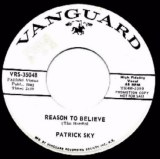 VRS-35048 - Patrick Sky : Reason to believe / Guabi, guabi (1966)
|
Vanguard, in addition to remixes of tracks from the artists' latest LP, they also did a number of orignal such as : Patrick Sky (seen at left), who had at least two non-LP singles : "Reason to believe"/ "Guabi, guabi", and "Love will endure"/ "Keep on walkin".
Joan Baez released "Pack up your sorrows" and " The swallow song" , two songs from her aborted rock album (produced by Richard Fariña, who also played dulcimer on one) in the summer after his death, (seen halfway up the page in promo and stock releases).
|
While Vanguard, Elektra and a few of the other 60s folk labels carried what would, in time, turn out to be a more impressive talent roster, it was always the suits and the major labels that got the hit singles.
Thus was the ultimate power of the old payola roll blues expressed.
At least until they got used to folk bands playing loud and electric and started signing bands the major labels were afraid of - and thus was born the underground...
|
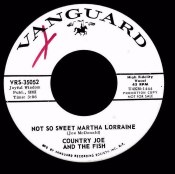 |
VRS-35052 : Country Joe and the Fish : Not so sweet Martha Lorraine / Masked intruder (promo) - released July, '67
|
Ó 2002, 2009, 2010 Greg Pennell
last updated 3/3/10
|